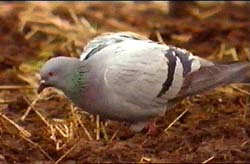
Wild Species of Columba
by Frank Mosca
Wild Rock Dove, Columba livia, Scotland
Photographer unknown
The sad fact is that it often appears we think about the feral, domestic, or common pigeon (Columba livia) in a sort of vacuum. We talk about it like it's sprung full-blown into existence from nothingness or that it's simply "the" one and "the" only pigeon wandering about the wild. It ain't so. There are a lot of pigeons and doves. (The words are interchangeable. In English, we simply tend to use "dove" for smaller species and "pigeon" for larger ones.)
On another page, I've pictured a few species, including fruit doves, and briefly mentioned that our domestic birds had lots of close cousins and other more distant relatives. ("Recent DNA evidence suggests that there are no extant relatives of pigeons and doves and that they should be the only family in Columbiformes.")
Here, I'd like to show you one of the closest to the domestic pigeon. Evolution is a wonderful and powerful force and it's created many different species. Below is one that could be considered a "first cousin" to our birds, which are descendants of the Rock Dove (Columba livia) pictured above. The bird is the Stock Dove (Columba oenas). Note the similarities as well as the differences to the Rock Dove (Common Pigeon) of Europe . The Stock Dove is obviously very closely related, but the area of iridescence on its neck is less. Its eyes are dark colored rather than the red of C. livia; its beak light, and both bars reduced to lines of only one or two spots. Additionally, though you can't see it in this photo, the rump is the same color as the rest of the bird and not light as it is in the European Rock Dove. Both pigeons are almost identical in size, about 230-370 grams and about 33 cm. in length. Both have a rounded tail, with the dark subterminal bar, but the Stock Dove doesn't have an albescent strip on the outer two tail feathers. (If this were a domestic bird, I'd say it was likely carrying smoky and dirty. Whether this species is homologous or not to C. livia at those loci, I'm not sure. I've never seen a live specimen.)
The Stock Dove's behavior is a bit different also. It will nest in tree holes as well as in cliffs, while the Rock Dove prefers cliff or artificial ledges. Both species are monogamous, lay two eggs, and have an incubation period of about 17-18 days. While their voices are different C. livia will pair with C. oenas, however, any young are very apt to die at about 10 days. (Darwin 1868)
Stock Dove, (Columba oenas)
A wild cousin of the domestic or common pigeon (Columba livia)
Photo copyright by Sue Tranter. Used by permission & just too beautiful to cut in size.
(Photo and linked to her site, which has some of the crispest bird photos I've seen anywhere.)
References:
Darwin, Charles, 1868, Variation of Plants and Animals Under Domestication, V. 1, p. 118
Sue's Bird Photos: http://www.suesbirdphotos.co.uk/index.html
Oiseaux.net: Pigeon colombin: http://www.oiseaux.net/oiseaux/columbiformes/pigeon.colombin.html